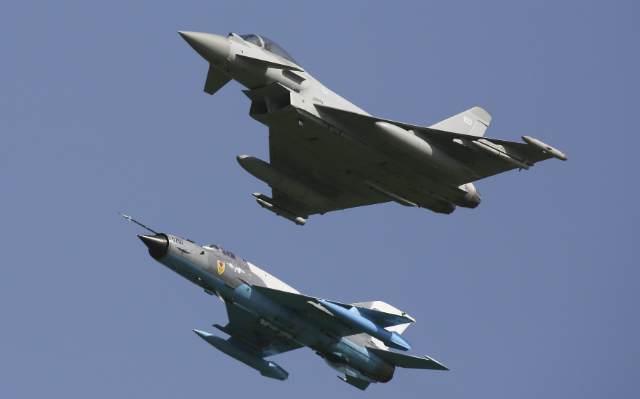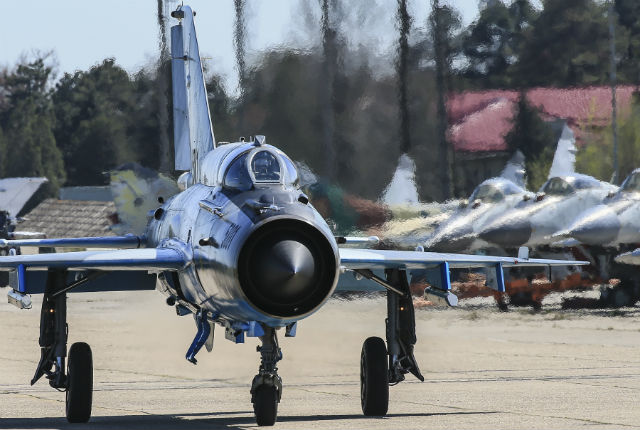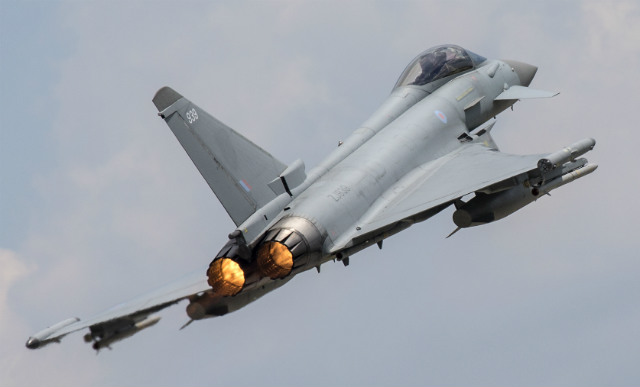Through a shimmering heat haze, the pilots of two sleek combat aircraft run to their jets, armed and ready beneath makeshift sun shelters on a Romanian base near the Black Sea coast. These are not the crews of the home nation's Aerostar-adapted MiG-21 Lancer interceptors, however, but of Royal Air Force Eurofighter Typhoon FGR4s, deployed to help safeguard NATO territory.
Located near Constanta, Mihail Kogalniceanu air base is home to one of the alliance's enhanced air policing missions, where since early May responsibility for the quick reaction alert (QRA) cover of Romanian airspace has alternated, one week at a time, between MiG-21s and four visiting Typhoons.

Crown Copyright
The first operation of its kind on Europe's southeastern flank, the arrangement is one example of the assurance measures adopted by NATO after Russia's annexation of Crimea from Ukraine in 2014. The RAF describes its current commitment – named Operation Biloxi – as intended to "demonstrate the collective resolve of allies, the defensive nature of NATO and deter the threat of Russian aggression".
"The mission is not to take over from our Romanian colleagues – it's to supplement," says Wg Cdr Andrew Coe, commanding officer of the RAF's 135 Expeditionary Air Wing (EAW). It also has provided the toughest test yet of the service's ability to operate its Typhoons from a remote facility with limited established infrastructure.
FlightGlobal visited the Romanian base on 7 August as mainland Europe baked in a summer heatwave of above 35˚C (95˚F), and as the UK was nearing the end of its four-month period of duty.
Coe says that when he first arrived in late April – in darkness, aboard an Airbus Defence & Space A400M tactical transport – he was greeted by blizzard conditions, high wind speed and very little in the way of facilities to support a sophisticated combat aircraft.
"The Romanian air force are really gracious hosts, and they gave us what they could," he says.
Two buildings previously used to house fire trucks were rapidly prepared as a headquarters and support facility for 135 EAW, and temporary shelters were added at the end of the runway for two of the arriving fighters.

Crown Copyright
Headquartered at RAF Leeming in Yorkshire, the expeditionary unit has drawn together just over 140 personnel from more than 20 sites in the UK, including the service's Typhoon main operating base at Coningsby in Lincolnshire, and others including Brize Norton, Lossiemouth and Valley.
Four or five pilots are included in this total at any one time, and are replaced around once a month. Primarily drawn from 3 Sqn at Coningsby, they are augmented by one pilot from elsewhere within the service's Typhoon force.
A combined six A400M, A330 Voyager tanker/transport and Lockheed Martin C-130J flights were required to deploy the bulk of personnel and equipment, while around 30 ISO shipping containers arrived by sea. Ground support vehicles such as generators and fuel and fire trucks were also transported from the UK.
"I brought a mini air force, and it shows that you can deploy and operate the Typhoon successfully," says Coe. "You don't have to have hundreds of computers and hundreds of technicians – we can do it from quite an austere base."
Due to a perceived high risk of its aircraft being affected by foreign object damage (FOD), the RAF also brought a runway-sweeping vehicle and a pair of spare Eurojet EJ200 engines for its Typhoons, which have not been required.
Although it has hosted MiG-21s for the last several years, Mihail Kogalniceanu is traditionally a helicopter base, with Romanian air force IAR Brasov SA330 Puma transport/assault rotorcraft operating from the site. A permanent detachment of US Army Sikorsky UH-60 Black Hawks is also present, sharing the same ramp area as the Typhoons.
"We've almost had to introduce a FOD-aware culture" on the base, says Sqn Ldr Paul Hanson, chief of staff operations for 3 Sqn. "The MiG-21 appears to eat FOD quite happily, but the Romanians have discovered with their [Lockheed] F-16s that it's not the case with a more modern aircraft."

Crown Copyright
Infrastructure at the site is currently being improved, with the foundations recently laid for a new hangar – one visiting Typhoon can currently make use of an existing structure if work is required.
The RAF deployed Tranche 1 aircraft which have passed through the EP1 enhancement programme, and due to the EAW construct they are flown without squadron markings. Flight Fleets Analyzer records the single-seat aircraft as aged between 10.1 and 11.4 years. Among the earliest of the UK's Eurofighters, they will be retained in use until at least 2030, with the air policing role likely to remain a priority.
"Our serviceability has been good out here," Hanson says, pointing to the strength of the unit's logistics planning.
While two of its aircraft are "standing Q", the detachment's other Typhoons conduct training flights with assets from Romania and nearby nations, and such activities also take place during "off" weeks. Coe says a total of around 24 to 28 flights are made per week.
Air policing duties are tasked from a NATO combined air operations centre in Torrejon, Spain, via a command and control centre in Bucharest. Hanson says the way in which such missions are allocated and monitored is exactly the same as they would be for a Typhoon pilot scrambling in the UK.

Crown Copyright
A first – and so far only – "Alpha" scramble was performed late last month, when a Typhoon was sent up to monitor the movements of two Russian air force Tupolev Tu-22M3s, which the RAF says were "heading south near NATO airspace".
"The jets did not come within visual range of each other," the service says, with the strategic bombers having remained in international airspace before departing the area.
"There are a lot of Russian aircraft based in Crimea at the moment, and they exercise in the Black Sea," Hanson notes. "There is a bit of an understanding as to what each other gets up to – it's very much day-to-day business for us, and for them." However, the level of activity fell markedly before the RAF duty began – possibly due to factors including the completion earlier this year of a deployment near Syria by the Russian navy's lone aircraft carrier, and a major gunnery competition currently being performed by its air force.
Further training, or "Tango" flights, have also been made by the two QRA-tasked jets, which are armed with MBDA Asraam short-range air-to-air missiles and a Mauser 27mm cannon, and could also carry medium-range Raytheon AIM-120 AMRAAMs.
RAF jets also appeared in the static display at a recent air show in Bucharest, and training and familiarisation flights have been conducted with the host nation's MiG-21s and newly-fielded F-16s.
Romania's MiG-21s – two of which remain on standby while the RAF aircraft are on QRA duty – are armed with Rafael Python II short-range air-to-air missiles and a pod-housed gun. "It's good, and they know how to use it well," Coe says. "We've learned quite a lot from those guys, and vice-versa. They've helped us in terms of airspace and where we are and what we're doing."
Hanson says the RAF's presence has also enabled the Romanian air force to use the F-16's Link 16 datalink capability across the same network for the first time – an advance he describes as "a great story for interoperability".
"We don’t have to be on quick reaction alert to do a NATO mission," Coe says. "This is the Royal Air Force operating in southeastern Europe and working with colleagues with whom we don't often get an opportunity [to co-operate with]. The great thing is, all of our NATO allies want [to work with] us."
UK Typhoons have also trained with Bulgarian MiG-29s and Hungarian Saab Gripens, along with Greek F-16s and US Air National Guard Boeing F-15Cs operating from Romania's Campia Turzii base.
"We're probably having a greater effect with our strategic messaging during those defence engagement weeks," Hanson says of the joint training activities. With the work largely having involved within-visual-range manoeuvring, he notes: "Typhoon has been shown off to its greatest capability."
Using a Rafael Litening III targeting pod, the aircraft have also taken part in close air support training involving the US Air Force, US Marine Corps and Romanian military, and during air/maritime integration training with a NATO naval task group. Its pilots will also train with their Turkish air force counterparts before the detachment concludes.
The Romanian deployment has built on the RAF Typhoon force's regular contribution to NATO's Baltic Air Policing mission, which involves sending aircraft to Estonia and Lithuania. At the end of Operation Biloxi, a Voyager and two Eurofighters will visit Amari air base, to exercise with the Estonian air force and locally-deployed UK ground forces. This will come as the UK detachment hands over the shared QRA duty at the end of August to Royal Canadian Air Force Boeing F/A-18s.
"What we have achieved here politically is ground-breaking stuff – it's never been done before," Hanson says. "We're proud of the faith that the Romanians have placed in us."
"Having a Royal Air Force Typhoon land just shows to everybody in NATO we really mean business," Coe says. "We are here, and working together."
Source: FlightGlobal.com


























